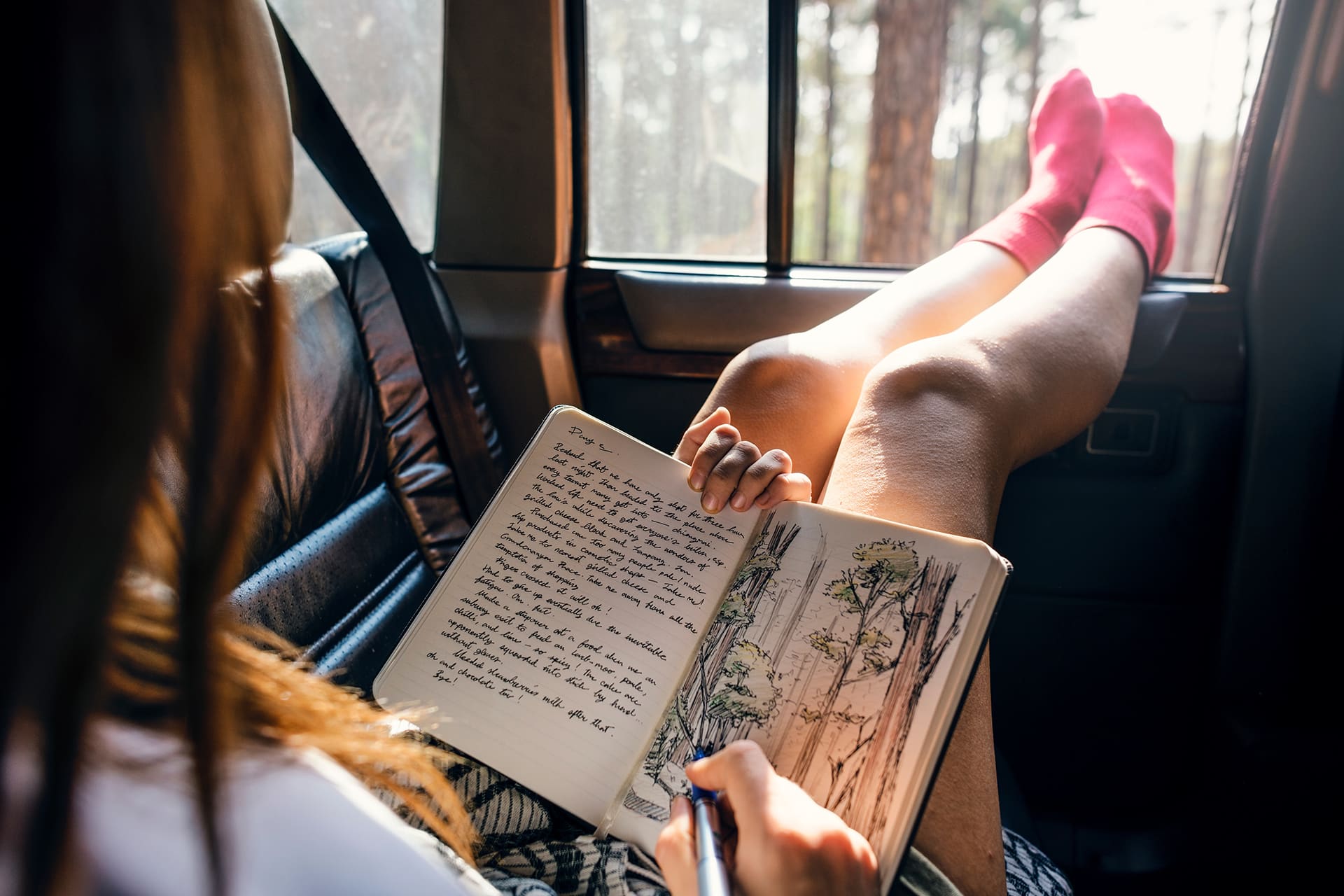How can you keep your relationship with plants fresh over time? How can you tend your seedling plant-and-person relationships, even as you move, change, get busy, and more?
Journaling is an embodied practice that connects mind and body by bringing pen to paper. A journaling session may invite surprising new insights, or even a cathartic release. The hidden potential of your subconscious — and the subconscious Heart of the world — finds a path to emergence.

Writing Warm-Up
Beginning with an empty page can be daunting. Start your journaling practice somewhere. Calibrate your body with your breath by doodling breath waves and spirals or river-writing. Here’s how to work with these effective tools…
Breath Waves and Spirals
- Place your pen on the page.
- As you inhale, trace upwards. As you exhale, trace downwards. Keep following your breath. You can create waves across the page or spiral from a central point outwards.
- Repeat until you feel complete, or fill a page. You can also set a timer for 1–5 minutes, for a mini mindfulness practice.
River-Writing
- Set your timer for 1, 2, 5, or 10 minutes.
- Write without stopping or censoring for your allotted time. If you run out of things to write about, then focus on sensory details around you. Just keep writing.

The Benefits of Journaling Prompts
Sometimes our Muse is ready at the helm, and we write easily. Other times our Muse is coy, recalcitrant, or even rebellious, and words are elusive. Writing forms can help create structure for your Muse so that regardless of external potential chaos, you have steady practice places to come home to. Try the different practices here. Notice what speaks to you. Return to that. Keep the rest in your pocket as touchstones of possibility, as soul-candy for those dark and stormy nights where something is needed, but nothing arises organically. You now have these tools. Keep writing.
Journal Prompt One: The Art of Observation
Find a plant. Notice what is right in front of you. Begin by line-drawing, quickly outlining exactly what you see without embellishment, without lifting your eyes from the plant, and without lifting your pen from the page. Spend one minute here, nothing fancy, nothing precious. You are just breathing, meandering a line around the page.
Then, begin writing. Begin with what is here, with sensory observation. What do you see? Smell? Feel? Hear? Taste?
Proceed from the visible to the invisible, to your felt sense of emotions, memories, and intuition. What else arises, as I pay attention?
Expand your perspective. Note habitat. What else grows here? Who lives here?
Note time. What time of day is it? How are the shadows adjusting to this timing? How does the landscape express the current and upcoming seasons?
How does this plant experience this? Sitting quietly near this plant, take a few deep breaths and let your mind become still. Bring your questions about the plant’s experience to your mind. See what answers may arise. They may be in the form of words or pictures or feelings.. Perhaps more questions arise. Trust what comes, and perhaps continue the conversation, asking more questions and continuing to listen.

Journal Prompt Two: Diving More into River-Writing
In connecting the river-writing warm-up with one plant, we welcome and have a sense of appreciation for everything. Write without filtration. Allow whatever arises to flow out. Invite your imagination and intuition to dance with this plant. Free-associate. Write myths old and new. Ask questions. Doodle all over with words and images. Let your writing grow from a puddle into a lake. You can edit later. Just put down the words now. Write it down.
Experiment with different writing styles. Direct your writing with short sentences. Green leaf. Smooth margins. Pungent. These are small conversations. Succinct. Powerful. Fast-moving.
When ideas runneth over, you can separate them with line-breaks.
Line-breaks break up visual space.
They can create poetic forms.
- Lists and bullet-points can help organize information.
- Feels like this.
- Tastes like that.
Or you can make short paragraphs that keep your writing loose and free, unencumbered by the weight of the next form.
Experiment with long floral sentences, big adjective-filled sensory-overload run-on-into-a-whole-paragraph sentences that are like big wet sponges that squish, exuding the sweet stench of too many words and ideas crammed into one place, just running on and on, a school of rainbow fish glinting and flashing across the page unmoored yet tethered by their relationship to each other, a block of delicious cheese fermenting slowly within the waxen casing of the solitary sentence that fattens into a paragraph, with leaves, roots, shoots, flowers, fruits, and even seeds all interwoven into one rambly sentence that talks like an aunty that just won’t stop and is kinda annoying but also fun, and works when placed just right and, like the short form, is a type of river-writing that helps you flex your writing wings, discover fresh voices and styles that just might suit you, and keep inquiring, connecting, expanding, and evolving.

Journal Prompt Three: Exploring Inquiry
For this outdoor activity, you can walk with a question. You can write it down, or simply hold it with you.
Part of the medicine is crafting the question itself. How do you phrase your question as an invitation, to open up further dialogue, and deepen reciprocal understanding?
Ask your question aloud. Converse with trees, plants, and fungi. Dialogue with the land. Invite layers of meaning to unveil themselves, untucking their wisdom.
Experiment with asking a question, then reflecting it back to the landscape — have a conversation.
Possible questions (for self, plant(s), landscape, etc.):
- What’s alive for me right now? (What’s alive for you right now?)
- What’s challenging me right now? (What’s challenging you right now?)
- How are my relationships right now? (How are your relationships right now?)
- What am I grateful for right now? (What’s nourishing you right now?)
- How am I changing right now? (What’s changing in our environment right now?)
Write what you receive. Open to wonder.

Write On! The Practice of Journaling
Cultivate consistent creative connection by taking time in your daily life to write outside. If it’s too cold to be outside (or otherwise inclement weather), then sit by a window and feel your connection with nature. Keep a dedicated notebook. Commit to 1–3 pages every morning. Try on different voices and styles. Keep experimenting and playing. Write on!
Beyond the Journaling Journey: Share Your Writing
Savor the writing experience itself. Write just for you. And then, when you feel ready, share.
Botanical poetry & prose open the door wide for all kinds of botanically-oriented writing and sharing.
Monographs focus on one plant. You can include plant appearance, habitat, constituents, collecting considerations, preparations, medicinal uses, and other uses. Remember to include references!
Recipes can be short shares, or expand with botanical stories, observations, or miniature monographs.
Self-publish your botanical musings via a newsletter, blog, social media, or Substack.
Publish your botanical musings in your local paper, environmental organizations’ newsletters or blogs, or with herbally-focused publications like Plant Healer magazine.
Writing is medicine, art, expression, and connection. Writing can amplify curiosity, ameliorate turbulence, accentuate botanical and other explorations, and anchor you back to yourself and your values each day, regardless of where you are, or how “busy” you are. Dream big, write it down, and keep on writing.

Deepening Your Herbal Journaling Experience
Ready to dive more into your herbal journey? Sounds like it’s time to check out HerbMentor! HerbMentor is LearningHerbs’ comprehensive herbal education platform that gives you access to in-depth plant profiles, plant walk videos, and courses by expert herbalists like Rosemary Gladstar. These resources can serve as beautiful inspiration for your herbal journaling journey. Right now you can join HerbMentor for just $1.









Thank you for this inspiring post. I have recently been on the path of communicating with a few herbs in my garden and a tall Doug Fir tree. When still a classroom teacher with a thriving herb garden just outside my classroom, I often had students draw one of the herbs and then do a little internet research on the herb. I could have used some of these ideas back then. Going forward I will start using the journaling ideas and see where they take me.
We’re so glad you liked it, Kathy!
That’s so awesome, I love how you incorporated that into class. We hope you love the journal ideas.
This seems like a great idea… I tried a gratitude journal with Oprah, which petered out. I would like to combine both. I am artistic but ended up treating the gratitude journal as a chore. I was so busy way back then, running painting contractor business,. I am now retired from painting, because of Coved 19 lockdown. But… now I have gotten back into crafting and decorative painting to bring in extra cash; and my house has always looked like a jungle with tons of plants everywhere. I love this idea to turn all that into journaling. Thank you, I also love forest bathing including the evergreen hot tea ritual to honor the woods and Mother Nature. I have endless acres of virgin woods surrounding my house. I have also started roaming around my area and eating that which is growing wild and learning how special and nurturing and medicinal each weed really is to the human body, and for my fur-babies and all the woodland/migrating fauna. Thank you for offering this special learning experience; it is just what I was wishing/longing for.
We’re so glad you enjoyed it!
That sounds so great, forest bathing especially, is amazing.
Usually I do not read article on blogs however I would like to say that this writeup very compelled me to take a look at and do it Your writing style has been amazed me Thank you very nice article
You’re welcome! We’re glad you enjoyed it.
I am going to try this remedy ! Thankyou Is it best to use acid free paper when pressing and preserving my herbs ? I want to do this as a project this year ?
Acid-Free paper is definitely ideal when preserving! I hope you enjoy the project. :)